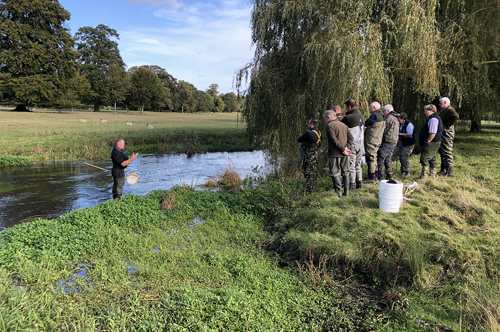SmartRivers enables volunteer ‘hubs’, supported by an IFM certified training scheme, to sample and analyse invertebrates to a near-professional standard.

Background
Volunteers are trained to sample adhering to the regulators three minute kick-sweep sampling guidelines and how to identify invertebrates relevant to their river to species-level.
Prior to training, all new river hubs select five sample sites based on where they have interests - for example above and below discharge points or restoration works. In the first year (spring and autumn) these new sites are sampled and analysed by a professional scientist to generate a ‘benchmark’ data set. This benchmark provides a scientific baseline for the river and underpins the volunteers’ identification training.
Training is two full days. Day one is where volunteers are taught to divvy up the habitats at their sites appropriately and sample using the correct technique. They also receive training on sample preservation and sorting. Day two is species identification training, where volunteers are taught how to use a microscope, split invertebrates up into categories and use a combination of resources (our family ID tool, an expected species list from the groups benchmarks and our invertebrate species image library) to make ID decisions. Once benchmarking and training is complete, the hubs sample independently, opting to either ID the samples themselves for free or send them away for analysis for a modest cost.
Whether identifying themselves or sending the samples away, all the species lists are plugged into our SmartRivers database, which is open access. Upon receiving a species list the database generates a water quality ‘scorecard’ with results for the impact of organic pollution, nutrient enrichment, sediment, chemicals and flow stress. Comparing scorecards along a river system allows us to identify water quality pinch points, highlighting where and what the pressures are. The raw species lists themselves are also incredibly useful, providing invaluable data on species distributions, as well as highlighting rare and invasive species.
When multiple years of data are available Salmon & Trout Conservation develop a comprehensive report looking at the outputs in context and facilitate next steps with the local group to take action.
Why is it relevant?
We’ve all seen the headlines about the national crisis our rivers are in. With only 14% in good ecological health, and every single one failing to meet chemical standards, it is clear the status quo is no longer an option. But, what does species-level invertebrate monitoring tell us about water quality?
Pinpointing water quality pressures: invertebrate species lists are logged in a central database which generates a water quality ‘scorecard’ for each river site sampled. These results describe the impact of organic pollution, nutrient enrichment, sediment impact, chemical presence, and flow stress based on what invertebrate species are present and absent. Comparing these scorecards along a river system – where water quality deterioration is not always obvious and pollutants are sometimes invisible to the naked eye - allows us to identify water quality pinch points, highlighting where and what the pressures are.
Understanding climate change: shifts in temperature baselines can lead to changes in the diversity of animals present in a river, altering food web structure and, ultimately, the health of other aquatic organisms such as salmon and trout. Research in Scotland and Wales has already shown that in higher altitude, northern rivers the cold-water loving invertebrates usually present are decreasing due to rising temperatures. One study showed that invertebrate abundance declined by 21% for every 1o Celsius rise in temperature.
Detecting invasive species: over 2,000 plants and animals have been introduced to Britain from all over the world. Most are harmless, but 10-15% spread and become invasive non-native species. Warming temperatures and poor water quality can cause ecological disruption that reduces the success of native species and result in non-native invaders establishing more easily. The coverage and resolution of SmartRivers monitoring can help us detect new invasive species, and better understand the spread of existing invasive species.
Providing a robust benchmark: We’ve all seen the headlines about the national crisis our rivers are in. With only 14% in good ecological health, and every single one failing to meet chemical standards, it is clear the status quo is no longer an option. Despite the shocking figures, coverage, resolution, and frequency of national monitoring regimes continues to decline. SmartRivers works to fill this gap, systematically collecting evidence of the problems.
The high resolution nature and quality control of the data gives regulators a resource that has the power to inform management priorities. It also supplements Salmon & Trout Conservation’s own policy work, where local SmartRivers case studies are used as evidence to challenge and improve water policy nationally.
How can i help?
The SmartRivers database is open to all, please
Email: smartrivers@salmon-trout.org to request a login.
A video demonstration on how to use and interrogate the database is available here: Smart Rivers video (YouTube)
For commercial purposes or publications please do not use our records without our prior consent. Please also credit where the records have been used.
Contacts and other important information
Contact: Lauren Harley, SmartRivers Project Manager
Email: smartrivers@salmon-trout.org
Website: https://salmon-trout.org/smart-rivers/
This page was added on 08 Apr 2022
Adobe Acrobat Reader is the free, trusted leader for reliably viewing, annotating and signing PDFs.
Download Adobe Acrobat Reader

